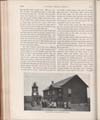
stnic.190605.001.001.jpg [illustration - Little Lucy Bull-Bear]
A LITTLE INDIAN SCHOOL
Out on the bleak prarie of South Dakota, in the valley of a little stream known as Wounded Knee Creek, there is a frame school-house where all the pupils are Indians. In the old days, before they were confined on the great bodies of land called reservations, the Indians used to hunt all over the great western country; and while none of them could read and write, yet even the small boys could follow a trail across the prairie many days after it was made, and they could tell, from looking at the pony-tracks, whether the rider was a white man or an Indian.
But after the last Indian war had been settled—after the braves had buried the hatchet and the "peace papers" had been signed by all the great Indian chiefs—the government built school-houses in many portions of the reservations, and white teachers were sent to teach the Indians how to read and to write and to become good citizens.
And the pupils are not all boys and girls, either, but there are some men and women in every school. In this particular school in the Wounded Knee Valley there is one boy about fifteen years old; the boy's father, who is forty-five years old; the boy's grandfather, an old man seventy years old, all going to school in the same room and all studying the same books and the same lessons; and the boy learns more easily and rapidly than his father or grandfather does.
When the little Indian boys and girls first come to school, they wear the picturesque clothes which the Indians wear in their half-savage state. But as soon as they are enrolled the government supplies them with clothing

stnic.190605.001.002.jpg
like that the white people wear. Here is a picture of little Lucy Bull-bear, just as she came to school the first day; but the next day little Lucy was dressed in a common calico dress, and her pretty Indian clothes were laid away. Lucy's father was a great warrior when he was a young man, and he was a great chief when he grew older; but he wants his little girl to learn to read and to write, to sew and to cook, and to keep house as white girls do.
Over at a school in Montana, a little Indian girl one day came to school wearing a purple velvet dress covered with two thousand elk teeth. The dress was made just like a meal-sack, with arm holes and a hole for the head; but the elk teeth are worth about two and a half dollars each, so that this little girl's dress could have sold for five thousand dollars.
The little Indians, when they first come to school, do not know how to do anything at all. They cannot even talk English, and first they have to learn a new language before they can learn to read. Yet they do this very quickly, and in a few weeks they can talk English quite well; but it takes a long time for them to learn to read. And all the time that they are learning to read and write, they are also learning to do the things which any little American boy or girl does naturally. The girls are taught to sew and to cook and sweep; while the boys learn to [illustration - Indian school at Wounded Knee Creek.] cut wood, to farm, and to take care of horses, pigs, and cows. The larger girls cook lunch for the little girls and boys, and all the schools are provided with kitchens and dining rooms. There is also a little farm attached to each school, and in it the boys grow all the vegetables eaten in the school.
When recess time comes, the little Indians get out and play just as the white children do. They have bows and arrows, balls and bats, and everything of that kind, and they make just as much noise as the girls and boys at any American school make.
White people used to think the Indians never smiled and never laughed; but that was because the Indians were shy and backward when white people were around. When the Indians get out by themselves, they laugh and joke and have great fun.
Every year three or four of the brightest pupils at each school are taken down to the agency, where the Indian agent lives, and are there placed in the boarding-school, which is equipped by the government. At this big school there are always several hundred Indian boys and girls, and the government pays all their expenses. Here they learn many things not taught at the day-schools. They have sewing societies for the girls and a printing office and a brass band for the boys. The girls

stnic.190605.001.003.jpg
[illustration - Indian tepees.]
make the clothes that both the girls and they boys wear, and the boys, in turn, make shoes for them all. The boys work the farm, and tend the stock, and work in the harness-shop and the carpenter-shop, and learn all sorts of useful things of that kind; while the girls learn to sew and to cook and to take care of a house.
But after the little Indian is through school he is still far, far behind the average white boy or girl; for he has never had an opportunity of seeing railroad trains and street cars, and electric lights and gas-stoves, and sewing machines, and thousands of things with which white children are surrounded.